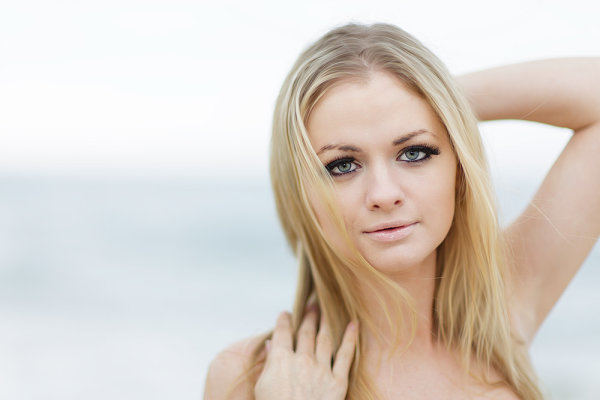
This was taken with the Canon EOS-1D X and EF 85mm f/1.2L II. I had a 600EX-RT speedlite on camera to provide just a touch of fill. Exposure was 1/250, f/1.2, ISO 100.
I am often contacted by people who are interested in modeling, either as a hobby, or to build a portfolio to try and model professionally. It’s one of the more fun things I get to do with a camera, as it allows me to be creative and really direct things a bit. Models can be great to work with- both to build their portfolio as well as your own. Aspiring models are often looking to diversify their portfolio, and are willing to trade time for images. I’ve developed working relationships with several models so that when I want to try something new, they are usually game. In addition, they will call me when they have an idea they want to add to their portfolio. This type of relationship can be liberating, since you are creating portraits for a client who is paying, and depending on your for an image. Rather, it’s a joint collaborative effort that yield phenomenal results.
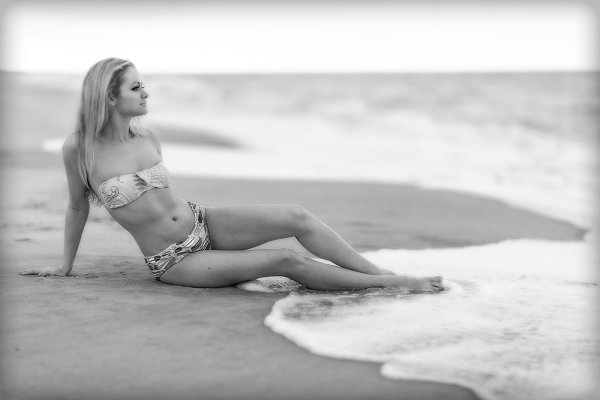
The headshot above was taken within the first few shots of the session. This one was the next sequence. I backed off to shoot her full length. Exposure 1/1250, f/1.2, ISO 100. Lens was the EF 85mm f/1.2.
I enjoy working on location with models because locations can offer a variety of settings. They also offer their own set of challenges. When I begin planning a model session, I propose several locations, as well as an overall concept. It’s important to agree on these things ahead of time so you are both on the same page for overall direction.
Once the shoot and location is agreed on, I always hold a discussion with my subject, discussing the goals of the shoot, as well as any ideas I had. I would ask the model to let me know if he or she had any ideas or shots in particular as well. Once the general concept is down, we discuss outfits. Many times the model will send me photos of outfits they have or want to try, and this will lead to more discussion. Generally, by the time this exchange happens, both myself and the model have a very good idea of what we want, and what the plan is, that when the day of the shoot comes, we’re ready to go with no questions. By the way, this process works great for my portrait sessions as well.
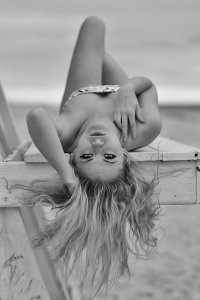
Locations present their own benefits. In this case, the lifeguard stand offered some nice options for posing. A reflector to the right of the model helped kick a bit more light into her face. EOS-1D X, EF 85mm f/1.2L II. Exposure is 1/640, f/2.8, ISO 100.
So we’ve discussed outfits, concepts, and location. Once I know what the model is looking for and what we want to do, I pack my bag. Camera body, speedlites, spare batteries, lenses. Which lenses? Depends on the shots I’m looking for, but my go-to lenses for portraits and models are pretty much the EF 85mm f/1.2L II, the EF 100mm f/2.8L IS Macro, and the EF 70-200 f/2.8L IS II. Depending on what else I’m looking for, I’ll use a EF 24-70mm f/2.8L II for wider shots that become more of a landscape with a model in it than a portrait. If I’m planning on using off camera speedlites, I’ll also bring however many I plan to use- usually two or three- as well as modifiers such as soft boxes. In addition, I ALWAYS have a reflector with me to use with both speedlites or natural light. Right now, my camera of choice is the Canon EOS-1D X.
You’ll notice my go-to lenses are all f/2.8 or faster. The ability to blur the background using a wide aperture is important to me, so anything distracting or unimportant can simply be blurred out. I like to show a context without being literal about it. So while you’ll see the sand and water in the background, it doesn’t have to be sharp. The furthest I’ll stop down, generally, is about f/5.6, but I normally will shoot at anywhere from f/1.2 to f/4.
When I do a model portfolio, or even a portrait shoot, I generally go in with an idea of the look I want to achieve. I try to maintain the same look for every file. When shooting on location, this assumes the light and the weather cooperate. Invariably, there are times when the weather does not cooperate and you have to adjust. The shoot that produced the accompanying photos are a case in point. I planned a sunrise shoot. I envisioned soft, warm, light on the model’s face, with orange glows on the sand and soft pink sunrise skies. Instead I got fog and flat grey clouds. Change of plans.
I pretty much decided when I arrived at the location that I was going to go for a monochromatic look. The light was flat, the sky was grey, everything just “felt” black and white. That’s not to say I didn’t do any color- but overall the look was for black and white. Generally when I’m shooting a model my goal is variety. If it’s for a portfolio, I want to be able to get several shots they can use for their book. I’ll work wider for full body shots, then close in for tighter head shots. I’ll generally let the model pose as he or she feels comfortable, tweaking the poses when I see something that needs to change- a tip or turn of the head, a repositioned hand, a stray hair.
I always have a reflector on hand. Even on a dull, cloudy day, a reflector can add enough punch to the light to create catch lights in the eyes, fill in the soft shadows around the eye sockets, and generally just make things pop better. I use a two-sided reflector by Westcott, with one side silver and the other side uncoated muslin. On a day like the one the accompanying photos were taken on, I used the silver side of the reflector since it kicked more like back up than simply using the white side.
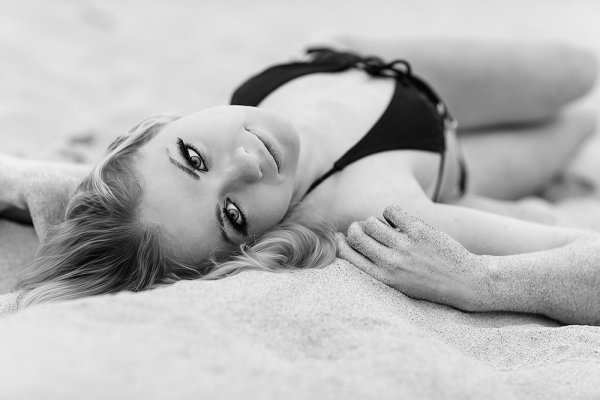
For this shot, I asked Yuliya to just pose in the sand. Rather than have her move, I moved around her 360°. She did her thing and we ended up with a few nice images. EOS-1D X, EF 85mm f/1.2L II. 1/250, f/2.8, ISO 100.
During the session, I try to mix full-length shots with tight closeups. Once I think we’ve captured the essence of the current outfit, I’ll quickly ask the model if there was anything else he or she wanted from it that we didn’t do, and then suggest a change to next one. This avoids belaboring one outfit or using so much time on one outfit that you don’t get to the rest.
I will show the model what I’m getting periodically so they know what we’ve got. The last thing I want to hear is that they wanted something we didn’t get, after the fact. This feedback is valuable because if the model doesn’t feel they look right, it can be changed before it’s too late. It also gives them an idea of what you’re capturing and allows them to modify their posing accordingly.
When it comes to processing the images, I try to make sure the look of all the files is fairly uniform. I want each session to stand alone as its own body of work. I do vary certain things, but generally I will use the same styles. Once all images are downloaded, I go through and choose the keepers. Then I process each, retouching the skin, the hair, and the eyes. To me, portraits and model photography isn’t about reality. It’s about flattery. You want to make your subject look good.
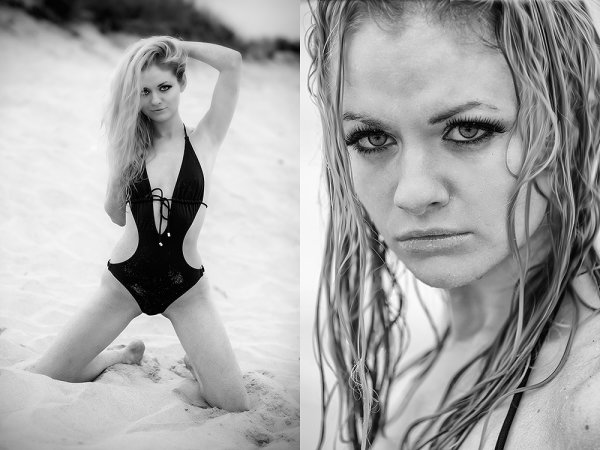
These two images were taken with the EF 70-200 f/2.8L IS II on the 1D X. It's one of my favorite lenses because it allows me to start off loose and then go in tight without being in the model's personal space.
Post originally from: Digital Photography Tips.
Check out our more Photography Tips at Photography Tips for Beginners, Portrait Photography Tips and Wedding Photography Tips.
Anatomy of a Modeling Session
You must be logged in to post a comment.